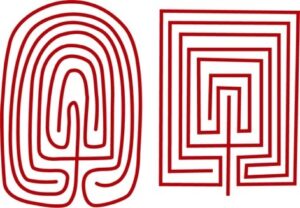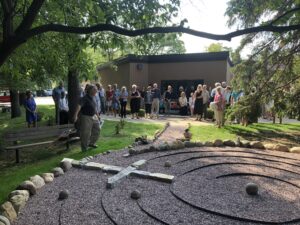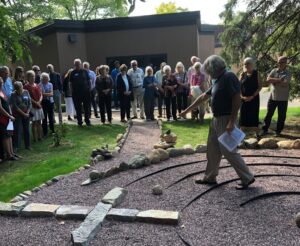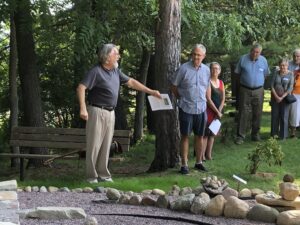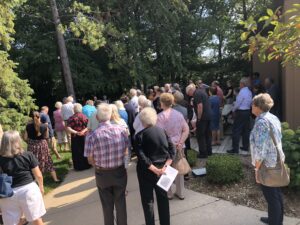“Broken for You”
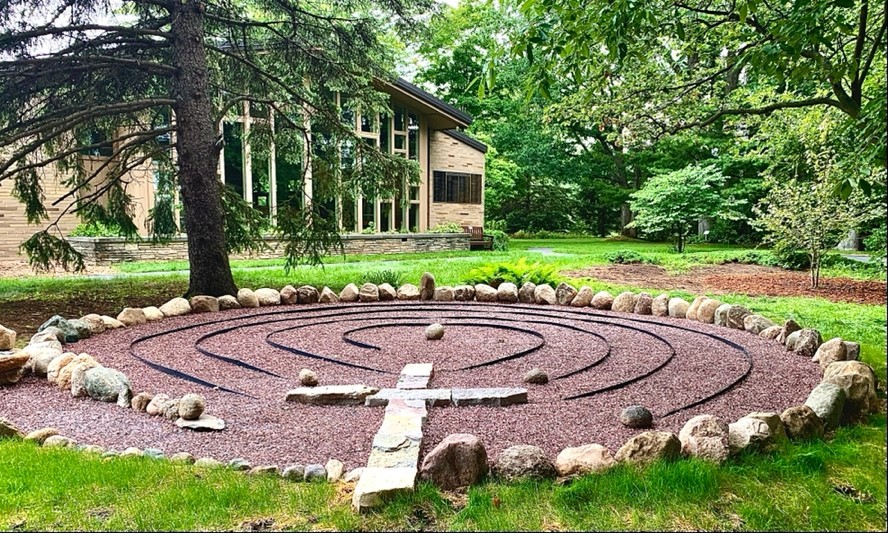
Construction Elements
During a recent vacation to New Mexico, I encountered and was impressed by the Hopi Indian labyrinth design. I had noticed the crisscross element in its construction and wondered if I could tweak it into a cross feature.
Whereas the Hopi design has a 7-path layout, I realized this would be too large for the 20-foot area allotted me in the Presbyterian Church Prayer Garden. So, I set out to create a 5-path design and try to shift the + element into a cross element. My attempts worked. Thus became the unique cross featured element of the labyrinth I entitled, “Broken for You.”
Once the 20-foot area was cleared for construction, I started by creating the cross. When I went to gather stones at a local landscape business, I noticed they had a pile of rejected stones that were priced at a discount. There I found the large, block stones which I fashioned into the broken cross feature. This brought to my memory:
Matthew 21: 42 “the stones the builders rejected has become the cornerstone: the Lord has done this, and it is marvelous in our eyes.”
So, the stones that the local builders rejected became the stones for the foundation of my labyrinth design.
Next, I oriented the cross on the eastern compass point of the outer circle.
Matt. 24:27: “For as the lightning comes from the east and flashes to the west, so also will be the coming of the Son of Man be.”
When I went to measure the circumference of the outside circle, I calculated that I would need about 60 twelve-inch sized rocks. I decided to buy 66 hand-picked large stones referring to the number of books in the Bible. There is a dividing stone on the western compass point, then 39 large stones are fitted on the north side circumference in reference to the Old Testament books and 27 large stones are fitted on the southern circumference representing the New Testament books. At the end of the southern circumference, I added a smaller stone line that ends with an arrow stone pointing to the broken cross, signifying that all these biblical books point to God’s redeeming grace there in the brokenness of Christ’s crucifixion.
The next construction work focused on the walking lanes. There are five circling paths that depict the swirling wind or fire of Pentecost. The path stone I chose is a light rose color when dry, but when baptized with moisture, it displays its flaming red color.
Acts 2: 1-3: When the day of Pentecost came, they were all together in one place. Suddenly a sound like the blowing of a violent wind came from heaven and filled the whole house where they were sitting. They saw what seemed to be tongues of fire that separated and came to rest on each of them.
There are four round stones placed at the ends of the traveling lanes and one at the very center of the labyrinth. Imagining a line drawn through the perimeter of these five points, a triangular shape comes to mind. For me this depicts the Holy Trinity, Father, Son, and Holy Spirit. Interim Pastor Leslie commented to me that these 5 stones reminded her of the Pentateuch, the five books accredited to Moses: Genesis, Exodus, Leviticus, Numbers and Deuteronomy. These five books form the theological foundations of the Bible.
Another note about these end point stones is that they are all very texturally rough except the middle eye stone which is smooth and white. This stone in “the Eye” is what I call the “Pearl Stone.”
Matthew 13:45-46: …the kingdom of heaven is like a merchant looking for fine pearls. When he found one of great value, he went away and sold everything he had and bought it.
What makes this labyrinth design truly unique is that the walking lanes always return to the cross. Isn’t this the ultimate statement of our Christian faith? It all comes back to the cross. Come what may, we believe that God goes with us, that God’s redemptive love surrounds our daily life, our daily walk, our daily trials.
Go with God and walk in peace my fellow pilgrims.
Doug Hansen, September 2022
Labyrinth Design & Construction
Randy Wendland, Construction Assistant
